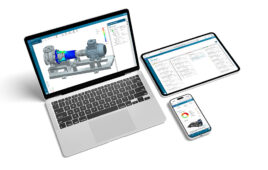5G will soon be deployed with its full set of features. As a communication tool, it puts more functionality in our hands than we’ve ever had before. Will we be ready for it, when it is ready for us?
By Scott Orlosky, Contributing writer
We’ve all been inundated by ads from Telecom Companies wanting us to adopt the latest 5G technology. Marketing aside, 5G is more than just another incremental step in the progression from 1G through 4G. It was designed to be a high connectivity, broadband, wireless, low latency communication platform. It has the same attributes that system designers are looking for to handle the massive amounts of data being generated and used to operate factories – and that’s no coincidence. Some of the performance characteristics that are supported by the 5G architecture include mission-critical communications, IoT, all spectrum types (licensed, shared, unlicensed); low, mid and high frequency bands and device-to-device and multi-hop mesh connectivity.
In broad terms there are three migration pathways from 4G to 5G based on the intended use. The first of these is eMBB or Enhanced Mobile Broadband. This is for existing systems that are built for 4G LTE applications where the higher bandwidth of 5G means faster download speeds, and a higher density of devices per square kilometer. This would also include higher mobility (think high-speed trains and airplanes) and potentially could take advantage of the lower latency of 5G. These are essentially extending the reach of existing 4G devices.
A growing area of use is in autonomous vehicles, both on-road and in controlled environments like warehouses and robotic manufacturing. This is referred to as URLLC or Utra Reliable and Low-Latency Communications. This involves incredibly fast turnaround, use of license-free bandwidth and data-sharing arrangements – all in the name of reliability. The goal is accurate data with low latency in situations where delays would result in a literal collision. One unique feature in this structure allows for critical signals to interrupt existing communication for safety reasons. This service level includes positioning information that would evolve to compete with localized GPS.
The third level of 5G engagement is mMTC or Massive Machine-Type Communication to support one million devices per square kilometer. In order to be effective as an IoT communication channel under the 5G NR (New Radio) standard it required the definition of two new device types. These are either NB-IoT (Narrow Band, 200kHz, Internet of Things) and CAT-M1 (1.4 GHz, Mobile). The NB-IoT variant is specifically for sensors or measuring devices which only need to perform their duty occasionally: things like flow measurement, tank level, overspeed indication, etc. This class of devices should be ubiquitous, cheap, and low power. The CAT-M1 is for devices that require the high bandwidth and low latency that you would find in an automation environment. Both can sleep for extended periods of time with extended Discontinuous Reception (eDRX) and Power Saving Mode (PSM).
Where is 5G capability now?
The original timeline was released by the 3GPP and IEEE in 2018 and the first specifications, released in mid-2019 are for use cases built on top of 4G LTE devices. At the time of that release, two more specification releases were planned over the next three years and then a fourth release at a later time, TBD. This rollout is different than any previous rollouts largely because of the added capabilities mentioned above and the wide amount of spectrum that will need to be sold off and regulated. In mid-2020, the latest release (release no. 16) was finalized. This is the one that starts to bring in the factory 4.0 features: Things like multi-user multiple input/output often referred to as Massive MIMO will speed up communication cycles; self-contain positioning (without GPS) that could allow for 3m positioning within a building, improving to sub-meter accuracy with release 17; 5G NR (New Radio) which uses unlicensed spectrum allowing for private local networks and TSN (Time Sensitive Networking) that can synchronize all devices on the network to the same clock as well as enabling vehicle-to-vehicle networking.
How bandwidth is allocated
Over the years, telecom companies have been accumulating license rights for voice and data for use in mobile phones, 1G through 4G. All of these frequencies are still available for 5G. However as can be seen by the chart and table below, 5G also potentially includes numerous additional frequencies. The FCC has made a commitment to an accelerated roll-out for these new frequencies under their 5G FAST plan. They have designated spectrum groups as High, Medium, Low and Unlicensed bands and have already, through an incentive auction, licensed the High band spectrum covering 28 through 48 GHz.


Example use cases:
Autonomous vehicles
One feature of 5G is the ability to designate certain information as mission-critical. Unlike 4G, 5G is allowed to assign priority to critical signals and can override other ongoing “conversations”. If a collision was imminent for example it could send an e-stop command to a piece of equipment, or sub-system. This supports the autonomous vehicle operating construct, but is also suitable for keeping Cobots safe, or emergency stops on conveyors or web processes, where an error can be costly in terms of product, and lost time to restart the process.
Monitoring
A lot of critical equipment is motor driven and when it is over-driven, or it’s near end-of-life, they can start to self-heat. A manufacturing plant could be fitted with IR cameras to cover critical operations and look for any anomalous heat events. These types of failures usually result in a shut-down, however when used for monitoring this could allow for a “run-safe” or “safe stop” operation. Then service could be scheduled with a planned shut-down which minimizes the disruption to production.
Augmented Reality/Virtual Reality (AR/VR)
These applications require lots of bandwidth and must have a low latency (< 1ms). In a VR application, the intent would be to use a headset or glasses as a teaching tool. An operator could learn things like testing protocols, assembly processes, or robot teaching methods. They could simulate a manufacturing environment and then run the simulation to ensure that it works as planned before committing capital expenditures. Augmented Reality, though similar to VR is a better tool for accessing CAD drawings, assembly drawings and tooling drawings in a graphic form. Most manufacturing facilities would produce these drawings routinely as part of the manufacturing process. Once those drawings are associated together through a number, an assembler can call-up these drawings during the product build. With these references, product assembly could be checked at each stage of assembly against the design and manufacturing template.
Local internet
With the luxury of a greenfield project or a small pilot plant, the high bandwidth and wireless connectivity of 5G installations could be used to build a local Internet today. It would be accessed directly through a local connection. In theory, sensors could send data directly to the cloud or local servers and prime movers (motors, actuators and robots for example) could access their instructions directly from a specific location. At present, not all sensors and prime movers are designed with IIoT in mind and so they don’t have the communication infrastructure. But, in the meantime, a plant can be built using one of the existing ethernet connectivity standards. As the 5G offering expands, communication could migrate to 5G wireless on a step-wise basis. Once fully deployed, the typical smart factory architecture could be built similar to the 5G smart factory with a cyber infrastructure as shown below.

Wrap it up
5G is coming on quickly and will be deployed with its full set of features within the next couple of years. As a communication tool, it puts more functionality in our hands than we’ve ever had before. The question now is, will we be ready for it, when it is ready for us?
Author Bio: Scott Orlosky has an MS in Manufacturing and Control Theory from UC Berkeley and has worked over 30 years designing, developing, marketing and selling sensors and actuators for industrial and commercial industries.
Filed Under: IoT • IIoT • Internet of things • Industry 4.0, CONNECTIVITY • fieldbuses • networks




